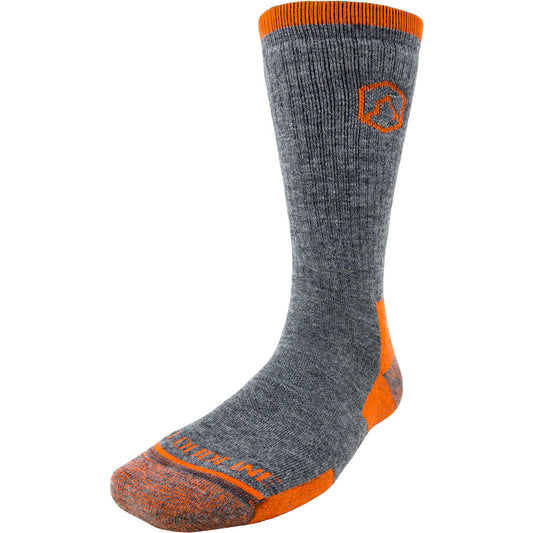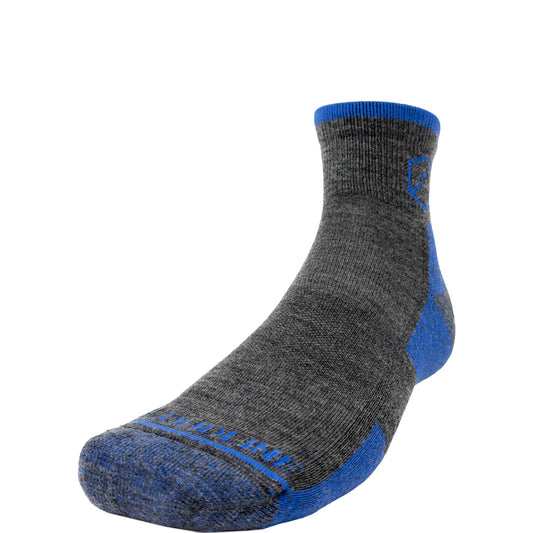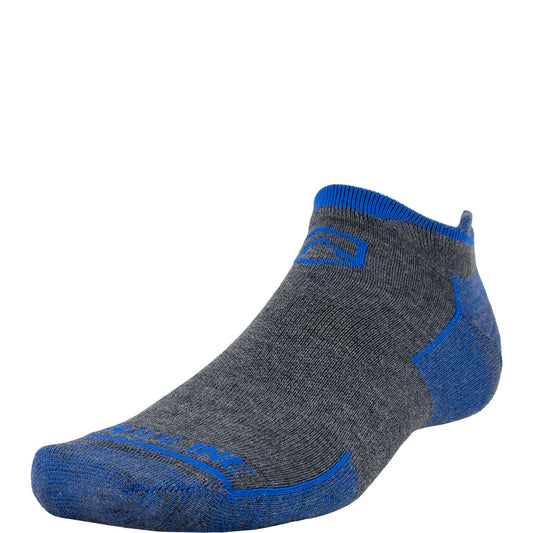
Conquer Trails in Comfort: Merino Wool Socks for Backpacking Adventures
Why Merino Wool Socks Are Essential for Backpackers
When you're miles from civilization with everything you need strapped to your back, every piece of gear counts—especially what's on your feet. The humble sock, often overlooked in the excitement of choosing the perfect pack or tent, can make or break your wilderness experience. Enter merino wool socks: the unsung heroes of the backpacking world.
I've logged thousands of trail miles across varying terrain and weather conditions, and if there's one thing I've learned, it's that your feet deserve premium protection. Merino wool socks aren't just another accessory—they're a fundamental component of your backcountry system.
Unlike standard cotton socks that quickly become soggy swamps when you sweat (and you will sweat on the trail), merino wool works with your body to maintain comfort through changing conditions. The microscopic structure of merino fibers creates a microclimate around your feet that regulates temperature, wicks moisture, and prevents the dreaded hot spots that lead to blisters.
But not all merino socks are created equal. The quality of the wool, construction methods, and thoughtful design elements separate trail-worthy socks from ordinary ones. Let's explore why dedicated backpackers consider quality merino wool socks an indispensable investment rather than an optional upgrade.
The Science Behind Merino's Magic
Merino wool's exceptional performance stems from its unique biological structure. Each fiber features microscopic scales and a complex internal composition that gives this natural material its remarkable properties. When examined under magnification, merino fibers reveal a sophisticated design that synthetic materials struggle to replicate.
At the core of merino's functionality is its extraordinary ability to manage moisture. The hydrophilic interior of each fiber can absorb up to 30% of its weight in water while maintaining a dry feel against your skin. Simultaneously, the hydrophobic exterior repels water droplets, creating an efficient moisture transport system that moves sweat away from your skin.
This isn't just marketing jargon—it's measurable science. Studies have shown that merino wool can absorb and release moisture vapor more effectively than any synthetic fiber, creating what researchers call a "dynamic buffer" against humidity changes. For backpackers, this translates to feet that stay drier through stream crossings, unexpected rain, or the inevitable sweating that comes with carrying a load uphill.
The crimped structure of merino fibers also creates countless tiny air pockets that trap body heat when it's cold while allowing excess heat to escape when temperatures rise. This thermoregulation occurs automatically, without any special treatments or chemicals—just nature's ingenious design at work.
The Unique Benefits of Merino Wool for Hikers
When you're logging serious miles on the trail, your sock choice becomes critical. Merino wool offers a constellation of benefits that collectively create an unmatched hiking experience. Let's break down what makes merino the gold standard for serious backpackers.
First and foremost is merino's remarkable moisture management. Unlike cotton that becomes waterlogged or synthetic materials that can feel clammy, merino wool continuously works to maintain optimal moisture levels around your feet. Even when partially damp, merino retains its insulating properties—a crucial feature when unexpected weather hits or during multi-day treks where complete drying isn't always possible.
The temperature regulation capabilities of merino wool socks extend beyond simple insulation. They create what's often described as a "personal climate control system" that works regardless of external conditions. This means your feet stay cool during strenuous uphill sections and warm during rest breaks—without changing your socks.
"After switching to quality merino wool socks, I finally completed a 20-mile day without a single blister. They've transformed my hiking experience completely."
— Experienced Continental Divide Trail Thru-Hiker
Perhaps most impressive is merino's odor resistance. The antimicrobial properties come from the natural presence of lanolin and the unique structure of the wool fibers themselves. These characteristics inhibit the growth of odor-causing bacteria even after multiple days of wear—a blessing for both solo hikers and their trail companions.
Comfort That Goes the Distance
The tactile experience of wearing premium merino wool socks distinguishes them from conventional alternatives. Unlike the scratchy wool of previous generations, modern merino feels soft against the skin—even comparable to cotton in comfort, but with superior performance characteristics.
This extraordinary comfort comes from the diameter of merino fibers, measured in microns. Quality backpacking socks typically use fibers between 17-19.5 microns—significantly finer than traditional wool and too small to irritate nerve endings in your skin. The result is a plush, non-itchy feel that prevents irritation mile after mile.
Cushioning is strategically placed in high-quality merino socks, with denser padding at the heel and forefoot where impact forces are highest. This anatomical cushioning creates a buffer between your foot and boot, absorbing shock without unnecessary bulk. The resilient nature of merino fibers means this cushioning maintains its protective properties throughout long treks, unlike synthetic materials that can compress permanently.
The elasticity of merino wool also contributes to its trail comfort. The natural crimp in each fiber allows it to stretch and return to shape repeatedly, ensuring your socks stay in place without binding or bunching—a small detail that becomes enormously important when you're covering serious distance.
Choosing the Right Merino Wool Socks for Your Adventure
Not all merino wool socks deliver equal performance on the trail. The selection process requires consideration of several key factors to ensure your feet receive optimal protection during your backpacking journeys.
Merino wool content is the first specification to evaluate. Premium backpacking socks typically contain between 60-80% merino wool, with the remainder comprised of complementary fibers that enhance durability and fit. Be wary of options advertising "wool blend" without specifying the percentage—these often contain minimal actual merino wool and won't deliver the performance benefits you're seeking.
Cushioning levels vary significantly across different sock models. For most backpacking trips involving substantial pack weight, medium to heavy cushioning provides ideal protection. Ultra-lightweight options may appeal for minimalist approaches or hot-weather hiking, while expedition-weight socks offer maximum insulation for cold conditions or high-altitude adventures.
The height of your sock should complement your chosen footwear. Mid-calf styles prevent abrasion from boot tops and offer additional protection from trail debris, while quarter-height options may suffice for low-cut hiking shoes in maintained terrain. Consider your typical hiking environment and the seasonal challenges you'll face when determining optimal height.
Matching Sock Weight to Your Hiking Style
Your personal hiking approach should inform your sock selection. The weight classification of merino wool socks—typically categorized as ultralight, light, medium, or heavy—indicates both the thickness of the material and the density of the knit.
Ultralight merino socks excel during summer hikes or in arid environments where heat dissipation takes priority over cushioning. These minimal options provide essential moisture management with reduced bulk but offer limited protection for rugged terrain or heavy loads.
Medium-weight options represent the versatile middle ground preferred by many backpackers. These socks balance thermal regulation with substantial cushioning, making them appropriate for three-season adventures across diverse landscapes. The adaptable nature of medium-weight merino wool socks makes them ideal for variable conditions or uncertain weather forecasts.
Heavy or expedition-weight merino socks deliver maximum insulation and protection. Their substantial construction excels during winter backpacking, high-altitude treks, or when carrying expedition-sized loads. The increased density provides enhanced durability alongside superior warmth, though they may prove excessive for mild conditions.
| Sock Weight | Best Use Case | Temperature Range |
|---|---|---|
| Ultralight | Summer hiking, hot weather | 70°F and above |
| Light | Warm weather, moderate trails | 55-75°F |
| Medium | All-purpose backpacking | 30-65°F |
Merino Wool Socks vs. Synthetic Alternatives
The debate between natural and synthetic materials has raged for decades in outdoor circles. When it comes to backpacking socks, merino wool offers distinct advantages over synthetic alternatives, though each has its place in the outdoor wardrobe.
Synthetic socks, typically made from materials like polyester, nylon, or polypropylene, excel in certain metrics. They generally dry faster than merino when completely saturated and often come with a lower price point. The engineered fibers can also enhance durability in high-wear areas through specialized construction techniques.
However, merino wool socks outperform synthetic options in several crucial categories that matter most during extended backpacking trips. The natural temperature regulation of merino functions across a wider range of conditions than any synthetic material, adapting automatically to both your body's changing output and external environments.
Perhaps most significant for multi-day backpackers is merino's superior odor resistance. While synthetic socks require chemical treatments to fight bacteria (treatments that inevitably wash out over time), merino naturally inhibits microbial growth. This means you can wear merino wool socks for consecutive days without developing the notorious "hiker funk" that plagues synthetic options.
The Environmental Consideration
Beyond performance metrics, the environmental impact of your gear choices merits consideration. Merino wool represents a renewable resource that biodegrades naturally at the end of its lifecycle, returning to the soil without introducing microplastics into the environment.
The production of merino wool, when responsibly managed, can actually benefit ecosystems through sustainable grazing practices that mimic natural patterns. Leading sock manufacturers increasingly source their merino from certified operations that maintain rigorous animal welfare standards alongside environmental stewardship principles.
In contrast, synthetic sock materials derive from petroleum products through energy-intensive processes. These materials shed microplastic particles during washing and wear, contributing to the growing problem of plastic pollution in waterways and wilderness areas—the very places backpackers cherish.
While no gear choice is without impact, merino wool socks represent a more harmonious option for environmentally conscious hikers seeking to minimize their footprint while maximizing performance. The extended usable life of quality merino socks further enhances their sustainability profile compared to less durable alternatives.
Caring for Your Merino Wool Hiking Socks
Quality merino wool socks represent a significant investment in your hiking comfort. Proper care extends their lifespan and maintains their performance characteristics through countless miles on the trail.
Contrary to common misconceptions, merino wool socks don't require elaborate care routines. Most premium options can be machine washed, though turning them inside out beforehand helps preserve the exterior finish and cushioning. Cold or warm water settings work well, but avoid hot water which may cause shrinkage over time.
Gentle detergents without enzymes or bleach provide effective cleaning without damaging the natural properties of the wool fibers. Specialized wool washes offer optimal results, but mild regular detergents work adequately in their absence. The key is avoiding harsh chemicals that strip the natural lanolin that contributes to merino's performance.
Air drying represents the ideal approach for merino wool socks, extending their lifespan significantly compared to machine drying. If you must use a dryer, choose the lowest heat setting to prevent shrinkage and fiber damage. Some backpackers alternate between multiple pairs, allowing each set to fully air dry between uses.
Extending Sock Lifespan on the Trail
Proactive maintenance during backpacking trips helps preserve your merino wool socks through challenging conditions. Simple practices significantly extend their functional lifespan without adding substantial weight or complexity to your backcountry routine.
Rotating between two or three pairs during extended trips allows each set to recover its loft and dry more completely between wearings. This rotation system prevents the structural breakdown that occurs when socks remain continuously compressed and damp for multiple days.
Field washing techniques maintain performance during longer journeys. At day's end, rinse socks in available water sources, gently squeeze (never wring) excess moisture, and secure them to the outside of your pack to dry during the following day's hike. This simple process removes accumulated salts and debris that accelerate wear and compromise comfort.
- Remove socks during extended breaks to allow both your feet and socks to air out
- Carry socks inside your sleeping bag at night in cold conditions to prevent freezing
- Address small holes immediately with basic darning techniques before they expand
- Store socks unfolded when not in use to preserve elasticity in the cuff
- Consider dedicated sleeping socks to extend the life of your hiking pairs
Frequently Asked Questions About Merino Wool Backpacking Socks
How Many Pairs Should I Pack for a Multi-Day Trek?
For most backpacking trips, carrying 2-3 pairs of merino wool socks provides an optimal balance between comfort and pack weight. This allowance permits daily rotation while keeping your load manageable. For trips extending beyond a week in remote areas, consider adding an additional pair as insurance against unexpected conditions.
The remarkable odor resistance and quick-drying properties of merino wool make this minimal sock selection practical even for extended journeys. Many experienced thru-hikers maintain this three-pair system across thousands of miles, washing one pair each evening to ensure a clean option always remains available.
Are Merino Wool Socks Worth the Higher Price?
While premium merino wool socks command higher prices than basic alternatives, their value proposition becomes clear when evaluated against their longevity and performance benefits. Quality pairs often deliver 500+ miles of hiking before showing significant wear—far outlasting cheaper options that deteriorate after minimal use.
When amortized across their functional lifespan, merino wool socks typically represent a lower cost-per-mile than budget alternatives requiring frequent replacement. Factor in the reduced blister risk, enhanced comfort, and decreased foot fatigue, and the investment becomes even more justified for dedicated backpackers.
What's the Ideal Merino Percentage in Hiking Socks?
The optimal merino content falls between 60-80% for most backpacking applications. This range balances the natural benefits of wool with the structural advantages of complementary fibers. Socks with merino percentages below 50% may not deliver the temperature regulation and odor resistance that distinguish wool from synthetic alternatives.
The remaining material composition typically includes nylon for durability, spandex or elastane for shape retention, and occasionally small percentages of other performance fibers. This thoughtful blend creates socks that harness merino's natural advantages while addressing its inherent limitations through strategic fiber integration.
Remember that the quality of the merino wool itself—not just the percentage—significantly impacts performance. Premium socks utilize fine-micron merino from specific sheep breeds raised in optimal conditions, resulting in superior comfort and functionality compared to products using lower-grade wool at similar percentages.
When selecting your next pair of backpacking socks, consider both the quantitative specifications and the reputation of the manufacturer. Established brands specializing in outdoor merino products typically deliver superior real-world performance through their material sourcing and construction expertise.




